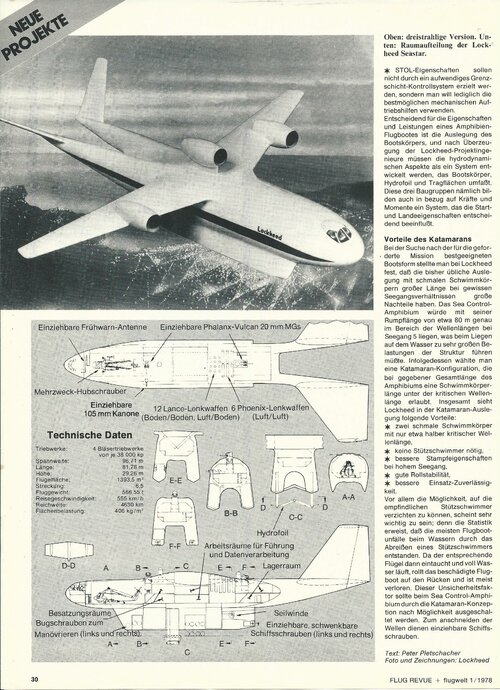- Joined
- 1 April 2006
- Messages
- 11,344
- Reaction score
- 10,016
Jemiba said:"The Russian put their eingine right in the front "
Another US used the same principle : Lockheed, too, designed
a WIG transport (from Flugrevue .9.78)
Jemiba said:May be right, probably there were several designs based on this concept
In the mentioned FlugRevue, the 4-engined variant was just described
as an amphibium with excellent characteristics on the water, due to its
catamaran layout. The ASW is said to have hydro skis and would have been
armed with Lance missiles (?), AGM-54 Phoenix, two 105 mm howitzers
(probably similar to the AC-130 gunship installation),2 Vulcan Phalanx
AND a Seasprite helicopter in an enclosed hangar !
The dream of my youth ! B)
Jemiba said:May be right, probably there were several designs based on this concept
In the mentioned FlugRevue, the 4-engined variant was just described
as an amphibium with excellent characteristics on the water, due to its
catamaran layout. The ASW is said to have hydro skis and would have been
armed with Lance missiles (?), AGM-54 Phoenix, two 105 mm howitzers
(probably similar to the AC-130 gunship installation),2 Vulcan Phalanx
AND a Seasprite helicopter in an enclosed hangar !
The dream of my youth ! B)
Probably not. "Thank" to the Vietnam war, Lance (MGM-52) was under consideration in the late 60s and 70s as a shipboard weapon for shore bombardment (in competition with a Terrier-derivative and possibly a new missile), for instance when a second modernization of the early Terrier cruisers with Mk-4 launchers and vertical missile magazines was considered (USS Boston CAG-1 and USS Canberra CAG-2; it didn't take place). This is coherent with the 105mm howitzers. Also the time-line for SeaStar points to Lance rather than Sea Lance. If I remember correctly, one issue of APR had a very interesting article on SeaStar.I believe Lance is a reference to the UUM-125 Sea Lance missile:
Wing-in-ground-effect (WIGE) transports would use a phenomenon that occurs when a plane flies near the surface: Wings get increased lift from a cushion of high-pressure air underneath and consequently require less power. The ground effect extends to an altitude half the wingspan. WIGE designs usually have stubby (low aspect ratio) wings for better low-speed control. They are usually seaplanes since they must fly over fairly flat surfaces with wing-tip end plates skimming over the wave tops. These NASA/Lockheed concepts would use a power-augmented ram affect to shorten takeoff and landing. Engines would tilt up, and exhaust would raise pressure under the wing. Speed would only be 400 mph. but payloads could be up to 750,000 lbs.
Stargazer2006 said:I've already posted this one somewhere.
hesham said:we must merge those topics;
hesham said:From Russian file 19/1981
Ooops, sorry for this double posting ! Maybe because I still have
difficulties, to regard WIGs as aircraft !
But as far as I now have searched this forum, this Lockheed project
wasn't posted before, the Seastar catamaran flying boat, intended
as a kind of "flying frigate", but as an amphibious transport, too.
4- and 3-engined variants were shown in FlugRevue 1/1978.

Hi,
here is two Lockheed Sea Control aircraft concepts,and the third is a helicopter,also
intended for Sea Control ?.
wouldn't a larger full fold out wing structure in addition to the SES variable geometry create a BWB (altitude aerial loiter), WIG (fast oversea dash) , SES (high speed sea dash, and very low depth water infiltration) super mobility craft?Hi,
here is two Lockheed Sea Control aircraft concepts,and the third is a helicopter,also
intended for Sea Control ?.
And,
